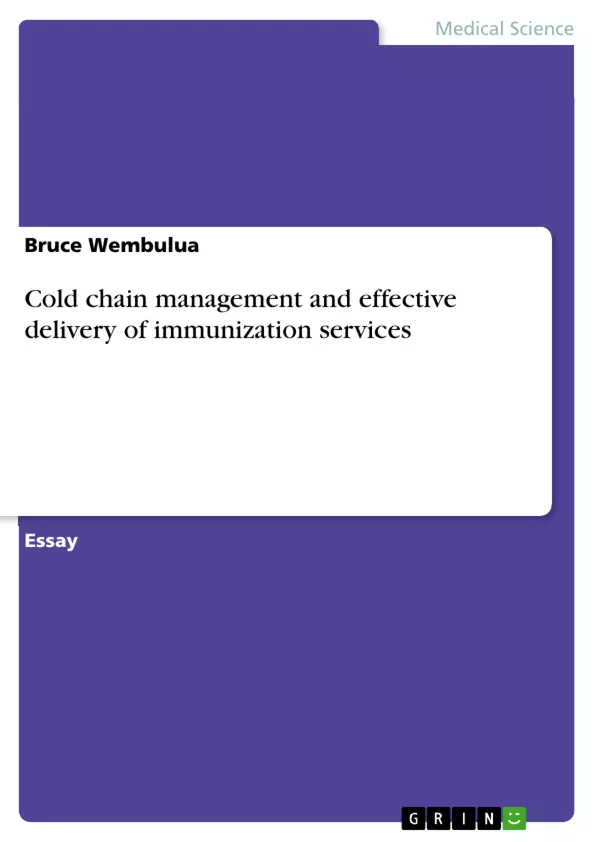Ancient Greeks had two gods of health: Aesculapius and Hygieia, therapy and prevention, respectively. Medicine in the twentieth century retains those two concepts, and vaccination is a powerful means of prevention.
Vaccines provide the immunity that comes from natural infection without the consequences of natural infection; help protect people from harmful infections before they come in contact with the disease.
All vaccines are thermo-sensitive and need to be properly stored and distributed. The success of an immunization program depends on a system that ensures that vaccines are not thermally damaged (by heat or freezing) during transport and storage. The system or network that ensures vaccines are transported and stored at and within the recommended temperature range of +2oC to +8oC from the place of their manufacture to the point of vaccine administration is called the “cold chain”.
The cold chain plays a crucial role in maintaining the potency and efficacy of vaccines throughout the immunization process and must therefore never be broken.
This paper investigates aspects of cold chain management, such as temperature monitoring and cold chain system logistics.
Inhaltsverzeichnis (Table of Contents)
- INTRODUCTION
- CHAPTER 1. COLD CHAIN TEMPERATURE MONITORING
- Recommended safe temperature range
- The Cold-chain Monitor
- The Vaccine Vial Monitor
- CHAPITER 2. THE COLD CHAIN SYSTEM LOGISTICS
- Essential elements of cold chain
- The Role of Cold Chain and Vaccine Logistics Management
- REFERENCES
Zielsetzung und Themenschwerpunkte (Objectives and Key Themes)
This paper discusses the crucial role of cold chain management in ensuring the effective delivery of immunization services within a country. It emphasizes the importance of maintaining the potency and effectiveness of vaccines throughout their journey from manufacture to administration.
- The impact of temperature on vaccine potency
- The importance of cold chain monitoring and measuring devices
- The role of cold chain logistics and management
- The use of thermo-sensitive indicators for tracking temperature exposure
- The application of Vaccine Vial Monitors (VVMs) to assess individual vaccine vial integrity
Zusammenfassung der Kapitel (Chapter Summaries)
- INTRODUCTION: This chapter introduces the concept of vaccination as a vital preventive healthcare measure and highlights the importance of maintaining vaccine potency through proper cold chain management. It emphasizes the need to ensure that vaccines are stored and transported within the recommended temperature range to prevent damage and preserve their effectiveness.
- CHAPTER 1. COLD CHAIN TEMPERATURE MONITORING: This chapter focuses on the significance of temperature monitoring in preserving vaccine potency. It elaborates on the recommended safe temperature range for various vaccines and introduces two essential monitoring tools: the cold-chain monitor and the vaccine vial monitor (VVM). It explains how these devices track temperature exposure and provide insights into potential damage to the vaccine.
- CHAPITER 2. THE COLD CHAIN SYSTEM LOGISTICS: This chapter delves into the logistical aspects of cold chain management. It outlines the essential elements of a comprehensive cold chain system, including storage, transportation, and distribution. The chapter emphasizes the crucial role of effective logistics in maintaining the integrity of vaccines from the point of manufacture to the point of administration.
Schlüsselwörter (Keywords)
The primary keywords and focus topics of this text include cold chain management, vaccine potency, temperature monitoring, cold-chain monitor, vaccine vial monitor (VVM), cold chain logistics, immunization services, and vaccine effectiveness.
- Citation du texte
- Bruce Wembulua (Auteur), 2016, Cold chain management and effective delivery of immunization services, Munich, GRIN Verlag, https://www.grin.com/document/344667



